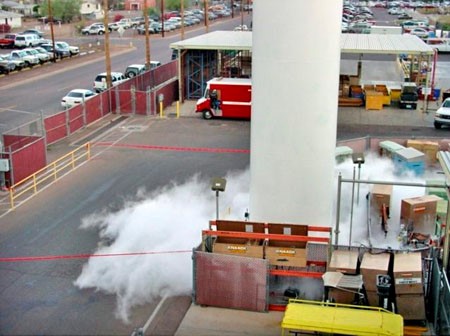Hydrogen Leaks
Because gaseous hydrogen consists of such a small molecule, very small leaks are common. In properly designed systems these very small leaks do not present a problem as the tiny amount of hydrogen released will not be enough to cause a flammable mixture in air. Only when hydrogen gas can accumulate over time in a confined area will a risk of a flammable mixture or asphyxiation arise.
- Small gaseous hydrogen leaks are difficult to detect by human senses since hydrogen is colorless, odorless, and tasteless.
- If hydrogen accumulates in a confined space in sufficient concentrations it, like all other gasses except oxygen, is an asphyxiant.
- Leaking hydrogen will rise and diffuse quickly in air because its low density results in high buoyancy (14 times less dense than air).
- Hydrogen mixes readily with air, creating an ignitable mixture (3x greater diffusivity than nitrogen in air). This hazard is especially important where hydrogen can accumulate in a confined area.
- Hydrogen mixes readily with air, creating an ignitable mixture (3x greater diffusivity than nitrogen in air). This hazard is especially important where hydrogen can accumulate in a confined area.
- Hydrogen leak detection methods include:
- Listening for high-pressure gas leaking (loud hissing sound).
- Using portable hydrogen detectors.
- Using permanently installed hydrogen detectors linked to local or facility-wide audible or visible alarms.
- Because liquid hydrogen (LH2) is a cryogenic liquid, leaks of LH2 behave differently than gaseous hydrogen leaks and may be easier to detect.
- Even in dry climates, a liquid hydrogen leak will create a white cloud of condensed water vapor due to the cryogenic temperature affecting condensing the humidity in the surrounding air. This low-temperature water vapor is heavier than air, so the cloud will remain localized and may move horizontally. As the hydrogen warms, it will dissipate and quickly rise.
A liquid hydrogen release will look similar to this liquid nitrogen release.
(Photo courtesy of Scott Stookey)
Leaks can create combustible mixtures of hydrogen and air, resulting in Flames or Explosions.
References
NASA White Sands Test Facility Hydrogen Plume Tests video (mov, 7.4 mb), filmed by ImageWorks for DOE.


